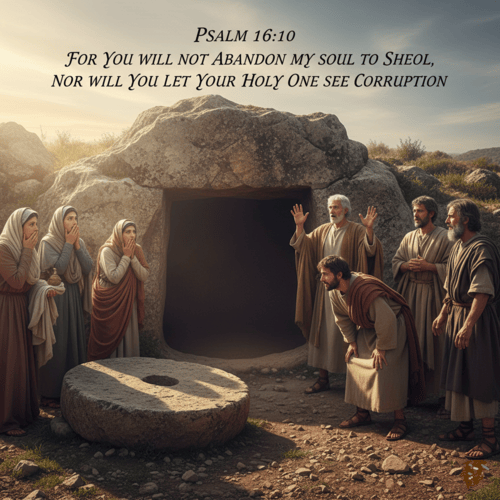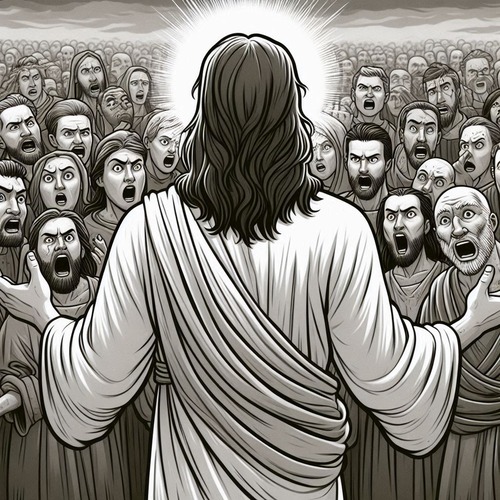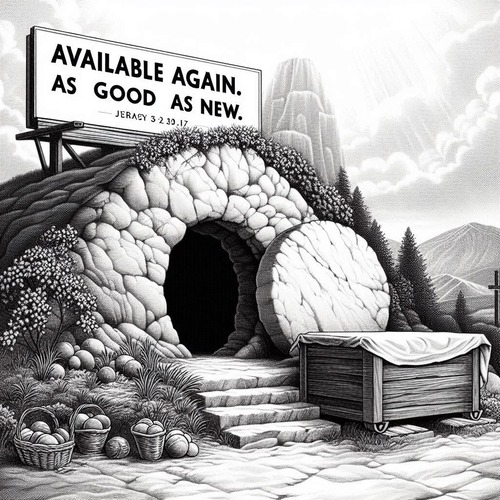Hidden In Plain Sight: Jesus’ Resurrection in OT Prophecy
When Jesus appeared to His disciples after His resurrection, He told them, “This is what I told you while I was still with you: Everything must be fulfilled that is written about me in the Law of Moses, the Prophets and the Psalms” (Luke 24:44). Yet many today—including some Christian scholars—question whether the Old Testament (OT) truly contains clear predictions of Christ’s resurrection. Some argue these prophecies are obscure, ambiguous, or only appear prophetic through creative, after-the-fact reinterpretation.
Is the resurrection of Jesus truly foretold In the Hebrew Scriptures, or are we reading New Testament (NT) meanings into ancient texts that weren’t intended to point to Christ’s victory over death? The question strikes at the heart of biblical interpretation and the unity of God’s redemptive plan.
The OT contains genuine prophetic shadows and types pointing to Christ’s resurrection when understood through covenant theology’s interpretive lens. The evidence, when examined honestly, indicates the resurrection was indeed “hidden in plain sight” throughout the Hebrew Scriptures—waiting to be fully revealed by the risen Christ Himself.
JESUS’ RESURRECTION IN OT PROPHECY: DIRECT REFERENCES
Psalm 16:10-11: One of the clearest prophetic references to the resurrection appears in Psalm 16:10-11, where David writes: “For you will not abandon my soul to Sheol, or let your holy one see corruption. You make known to me the path of life; in your presence there is fullness of joy; at your right hand are pleasures forevermore.”
This passage finds its definitive interpretation in Peter’s Pentecost sermon (Acts 2:25-31), where he explicitly connects it to Christ’s resurrection: “Fellow Israelites, I can tell you confidently that the patriarch David died and was buried, and his tomb is here to this day. But he was a prophet and knew that God had promised him on oath that he would place one of his descendants on his throne. Seeing what was to come, he spoke of the resurrection of the Messiah, that he was not abandoned to the realm of the dead, nor did his body see decay.”
Peter’s argument is compelling—David himself died, was buried, and his body decayed. Therefore, this prophecy finds its fulfillment not in David but in his greater Son, Jesus Christ, whose body did not experience decay because God raised Him from the dead.
Isaiah 53:10-12: Isaiah’s Suffering Servant passage contains a remarkable prophecy of resurrection, though it requires careful reading: “Yet it was the LORD’s will to crush him and cause him to suffer, and though the LORD makes his life an offering for sin, he will see his offspring and prolong his days, and the will of the LORD will prosper in his hand. After he has suffered, he will see the light of life and be satisfied; by his knowledge my righteous servant will justify many, and he will bear their iniquities. Therefore I will give him a portion among the great, and he will divide the spoils with the strong, because he poured out his life unto death, and was numbered with the transgressors.”
The logic here is inescapable: The ”servant is “crushed” and “poured out his life unto death,” yet afterward He “will see his offspring and prolong his days” and “divide the spoils with the strong.” This sequence necessarily implies resurrection—the Servant dies as a sin offering but subsequently lives to see the results of His sacrifice. Such a progression is impossible without resurrection.
Hosea 6:1-2: Hosea provides one of the most striking temporal prophecies related to resurrection: “Come, let us return to the LORD. He has torn us to pieces but he will heal us; he has injured us but he will bind up our wounds. After two days he will revive us; on the third day he will restore us, that we may live in his presence.”
While this passage directly addresses Israel’s hoped-for restoration, it establishes a prophetic pattern fulfilled in Christ’s resurrection “on the third day.” As with many Messianic prophecies, what applies to Israel finds its ultimate fulfillment in Israel’s Messiah, who represents the nation. The specific timing—“on the third day”—aligns precisely with Jesus’ resurrection timeline, suggesting more than coincidental correspondence.
TYPOLOGICAL PROPHECIES (BIBLICAL TYPES)
Jonah as a Type of Christ: Jesus Himself identified Jonah’s experience as a prophetic type of His death and resurrection (Matthew 12:40). Jonah’s ordeal (Jonah 1:17) wasn’t merely an interesting parallel that Jesus creatively applied to Himself—it was a divinely orchestrated foreshadowing of Christ’s resurrection. Jesus’ explicit application demonstrates He viewed the OT as containing intentional types that pointed to His ministry, including His resurrection.
The Binding of Isaac (Genesis 22): Abraham’s near-sacrifice of Isaac contains powerful resurrection imagery. Hebrews 11:17-19 reveals Abraham’s faith-filled reasoning. “By faith Abraham, when God tested him, offered Isaac as a sacrifice… Abraham reasoned that God could even raise the dead, and so in a manner of speaking he did receive Isaac back from death.”
Isaac’s figurative “resurrection” prefigures Christ’s actual resurrection. Abraham prophetically named the place “The LORD Will Provide” (Genesis 22:14), ultimately fulfilled when God provided not a ram but His own Son as the perfect sacrifice—a Son who would not remain dead but rise again.
Joseph’s Exaltation After Suffering: Joseph’s life story—betrayed by his brothers, left for dead, falsely accused, imprisoned, and then exalted to save many lives—presents a remarkable typological prophecy of Christ’s death, resurrection, and exaltation. Though no single verse explicitly connects Joseph to resurrection, the narrative pattern unmistakably foreshadows Christ’s journey from death to glory.
As Joseph declared to his brothers: “You intended to harm me, but God intended it for good to accomplish what is now being done, the saving of many lives” (Genesis 50:20). This same redemptive pattern finds its ultimate expression in Christ’s resurrection and saving work.
JESUS’ RESURRECTION IN OT PROPHECY
The Firstfruits Offering (Leviticus 23:9-14): The Firstfruits offering, presented the day after the Sabbath during Passover week, foreshadowed Christ’s resurrection. Paul makes this connection explicit: “But Christ has indeed been raised from the dead, the firstfruits of those who have fallen asleep” (1 Corinthians 15:20).
The ritual, observed for centuries before Christ, embodied Israel’s faith that the God who brings life from seemingly dead seeds would ultimately triumph over death itself. The timing of Jesus’ resurrection on the very day of Firstfruits reveals God’s precise fulfillment of this prophetic pattern.
Job’s Hope of Resurrection (Job 19:25-27): In perhaps the oldest book of the Bible, Job expresses resurrection hope. Job anticipates seeing God in resurrected flesh—a hope that finds its guarantee in Christ’s resurrection. This ancient text demonstrates that resurrection faith wasn’t a late development but was embedded in Israel’s earliest theological understanding.
ADDRESSING COMMON OBJECTIONS
“These passages are taken out of context”:
Some scholars, even Christian ones, argue NT applications of OT texts ignore their original context. They suggest the apostles employed creative hermeneutics disconnected from the original meaning.
However, this objection fails to appreciate the Reformed principle of sensus plenior (fuller meaning)—that Scripture texts may contain divinely intended meanings beyond what the original human authors fully comprehended. Peter acknowledges this when he writes that the prophets “searched intently and with the greatest care, trying to find out the time and circumstances to which the Spirit of Christ in them was pointing when he predicted the sufferings of the Messiah and the glories that would follow” (1 Peter 1:10-11).
Most significantly, Jesus Himself employed this hermeneutic when, after His resurrection, “beginning with Moses and all the Prophets, he explained to them what was said in all the Scriptures concerning himself” (Luke 24:27). Jesus clearly believed the Old Testament contained genuine prophecies about Him, including His resurrection, not merely texts that could be creatively repurposed.
“The Jews didn’t see resurrection prophecies here”
Another objection suggests if these texts truly prophesied resurrection, pre-Christian Jewish interpreters would have recognised them as such.
This argument overlooks evidence of resurrection hope within Second Temple Judaism, as demonstrated in texts such as Daniel 12:2-3, various Dead Sea Scrolls, and the Pharisaic tradition that Paul referenced in Acts 23:6-8. While not all Jews interpreted these passages as pointing to a dying and rising Messiah, the conceptual foundation was present. The Pharisees, unlike the Sadducees, firmly believed in resurrection as evidenced by their theological disputes recorded in the New Testament.
Moreover, Jesus specifically rebuked religious leaders for failing to discern these truths: “You study the Scriptures diligently because you think that in them you have eternal life. These are the very Scriptures that testify about me, yet you refuse to come to me to have life” (John 5:39-40).
“These predictions are obscure and ambiguous”
Some Christian scholars contend the resurrection prophecies are too vague, requiring the resurrection as an interpretive lens to become visible. Without hindsight, they argue, no one would naturally read these texts as predicting a dying and rising Messiah.
This objection has some merit—these prophecies often appear in forms that became fully clear only after Christ’s resurrection. However, this progressive revelation doesn’t invalidate their prophetic nature. Rather, it aligns with God’s pattern of unveiling His plan gradually throughout redemptive history.
As Jesus told His disciples, “I have much more to say to you, more than you can now bear” (John 16:12). God’s wisdom is evident in providing prophecies clear enough to authenticate Jesus once fulfilled, yet veiled enough that human actors remained free moral agents in the crucifixion drama.
JESUS’ RESURRECTION IN OT PROPHECY: REFORMED HERMENEUTICS
Covenant Theology as Interpretive Framework: Covenant theology provides the interpretive framework that shows us how Old Testament resurrection prophecies fit within God’s unified redemptive plan. Rather than seeing the Bible as a collection of disconnected texts, covenant theology recognises the progressive unfolding of God’s salvation through historical covenants, all finding their fulfillment in Christ.
The resurrection represents God’s vindication of Christ as the covenant keeper who faithfully fulfilled all covenant obligations on behalf of His people. The Davidic covenant promised an eternal kingdom (2 Samuel 7:12-13)—a promise requiring either immortality or resurrection. Christ’s resurrection establishes Him as the eternal Davidic king, demonstrating how covenant promises necessitated resurrection.
The Analogy of Faith Principle: Reformed interpretation employs the principle that “Scripture interprets Scripture,” allowing clearer passages to illumine more obscure ones. This approach recognises that later revelation (particularly in the New Testament) often provides the key to understanding earlier revelation’s full significance.
When Jesus declared, “Everything must be fulfilled that is written about me in the Law of Moses, the Prophets and the Psalms” (Luke 24:44), He established the interpretive principle that the Old Testament contained genuine prophecies about Him—including His resurrection—that found their fulfillment in His life, death, and resurrection.
CONCLUSION: JESUS’ RESURRECTION IN OT PROPHECY
When examined through covenant theology’s lens, Old Testament prophecies of Christ’s resurrection emerge not as obscure afterthoughts but as integral elements of God’s redemptive plan. From Psalm 16’s promise that God’s Holy One would not see corruption to Isaiah’s Suffering Servant who dies yet sees the light of life, from Jonah’s three days in the fish to the Firstfruits offering’s promise of new life, these prophecies weave together a tapestry of resurrection hope.
The fact that these prophecies become most clear in retrospect doesn’t diminish their prophetic nature but rather highlights God’s wisdom in progressive revelation. Like a masterfully
JESUS’ RESURRECTION IN OT PROPHECY: RELATED FAQs
Weren’t the disciples simply looking for any texts they could reinterpret to support their belief in Jesus’ resurrection? The disciples weren’t engaged in creative reinterpretation but were following Jesus’ own hermeneutic (Luke 24:27). Their interpretations aligned with established Jewish exegetical methods of their day. Furthermore, many of their interpretations required significant theological insight that would be unlikely if they were merely grasping for supportive texts.
- Why didn’t God make resurrection prophecies more explicit if they were so important? God’s wisdom in progressive revelation allowed human actors to remain free moral agents in the crucifixion drama. Explicit prophecies may have created a self-fulfilling prophecy scenario or prevented certain actors from participating in God’s plan. Additionally, the pattern of “mystery revealed” serves God’s purpose of drawing people into deeper study of His Word (Proverbs 25:2).
- Do any OT passages explicitly use the word “resurrection” in connection with the Messiah? No OT passage explicitly uses the term “resurrection” regarding the Messiah. However, this absence doesn’t undermine the prophecies since they clearly describe the concept using other terminology. The theological concept of resurrection is conveyed through descriptions of one who dies yet lives again, sees light after darkness, and experiences exaltation after suffering.
How do we know early Christians didn’t invent the resurrection story to match perceived prophecies? The historical evidence for Christ’s resurrection is substantial, including the transformation of the disciples, the empty tomb, and the shift from Sabbath to Sunday worship. Early Christians faced death for this claim rather than recanting, which is psychologically implausible for a known fabrication. Additionally, several resurrection prophecies were not widely recognised as Messianic beforehand, making it unlikely Christians retrofitted the story to match them.
- How do we respond to Jewish interpretations that reject Christian readings of these passages? While respecting Jewish interpretations, Christians recognise Jesus Himself claimed these texts pointed to Him. Different readings stem from different starting assumptions—whether Jesus is the Messiah or not. Jewish interpretations often acknowledge these texts contain resurrection themes but disagree about their Messianic application, which is primarily a question about Jesus’ identity rather than the texts themselves.
- If resurrection was prophesied, why were the disciples so surprised when Jesus rose? The disciples’ surprise demonstrates they weren’t looking to fulfil prophecies through fabrication. Ancient Jewish expectation generally focused on a general resurrection at the end of time, not an individual resurrection mid-history. The disciples, despite Jesus’ explicit predictions, couldn’t overcome their cultural expectations until confronted with the risen Christ, at which point the prophecies suddenly made sense.
Couldn’t these “prophecies” be examples of apophenia—finding patterns where none exist? The resurrection prophecies follow consistent theological patterns across multiple biblical authors spanning centuries. Jesus Himself validated these connections rather than disciples creating them post-hoc. Furthermore, these prophecies interlock with hundreds of other Messianic prophecies fulfilled in Jesus’ life, creating a cumulative case too extensive to be coincidental pattern-seeking.
JESUS’ RESURRECTION IN OT PROPHECY: OUR RELATED POSTS
Editor's Pick

Why Do People Hate the Doctrine of Election?
…WHEN THEY REALLY SHOULDN’T Few Bible doctrines provoke stronger reactions than election. The idea that God chose some for salvation [...]

The Doctrine of Providence: Does God Really Govern All Things?
You’re sitting in the doctor’s office when the diagnosis lands like a thunderclap. Your mind races: Why this? Why now? [...]

No Decay, No Defeat: What It Means That Christ’s Body Saw No Corruption
On the Day of Pentecost, Peter stood before thousands and made a startling claim: David's body decayed in the tomb, [...]
SUPPORT US:
Feel the Holy Spirit's gentle nudge to partner with us?
Donate Online:
Account Name: TRUTHS TO DIE FOR FOUNDATION
Account Number: 10243565459
Bank IFSC: IDFB0043391
Bank Name: IDFC FIRST BANK






